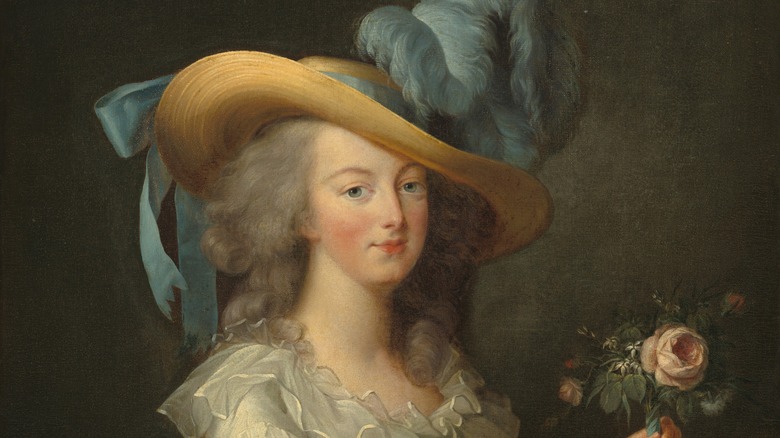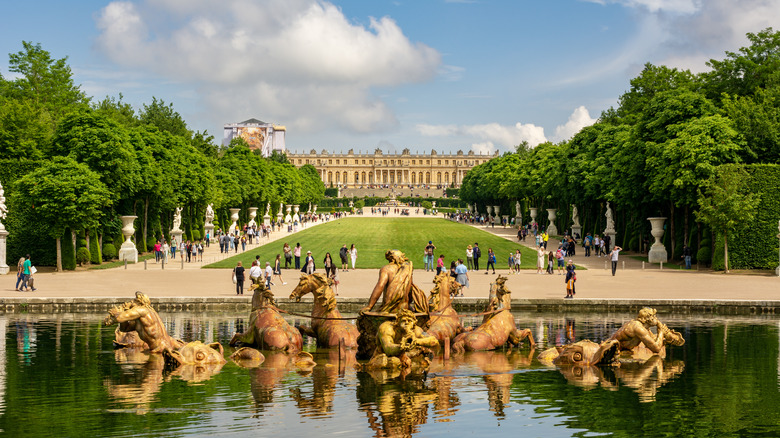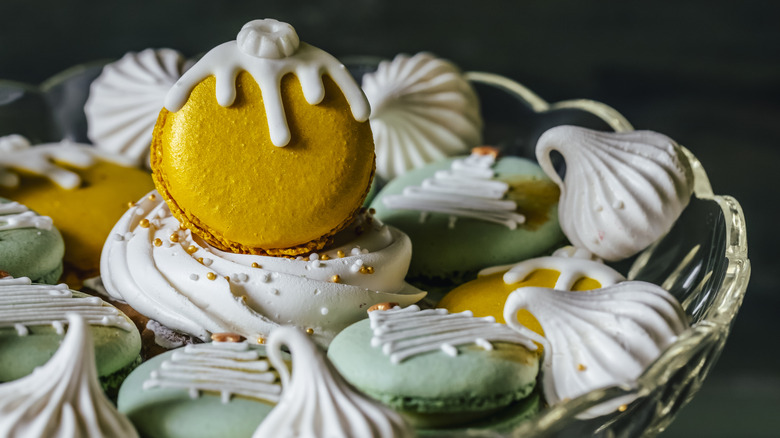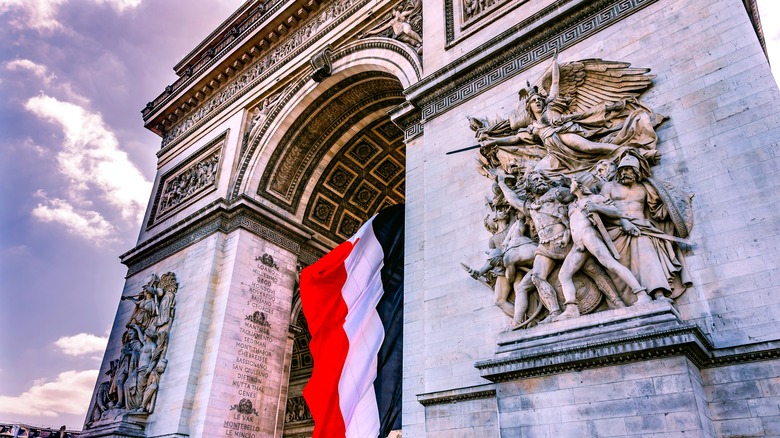Why Marie Antoinette Constantly Ate Fruit Out Of Season
Depending on who you ask, she was a historical villain, a victim of circumstance, or a symbol of royal overindulgence. Yes, Marie Antoinette was, to put it lightly, a complicated figure. The last queen of France before the French Revolution, which began in 1789, Marie Antoinette has become synonymous with the luxurious excesses of the French Royal Court, the sprawling and infamous Versailles. Perhaps this is because of that pesky "let them eat cake" quote, which has been falsely attributed to Marie Antoinette for centuries. Or maybe it has to do with the sumptuous Rococo aesthetics that have come to be tied to her image: her stacked and powdered hair known as the Pouf, for example; or the heaps of colorful French macarons and cakes, piled high with ornaments that mirror the draperies of Marie Antoinette's large and structured gowns.
Marie Antoinette's dining habits have become a historical fixation and cultural touchstone, but there are a few food facts about Marie Antoinette that are less well-known. Beyond the piles of macarons and tarts, Marie Antoinette also had a particular tendency towards eating fruit off-season. And no, this doesn't mean that she was getting her fruit from the discount bin. Rather, this habit was yet another display of the crown's luxurious tendencies, as Marie Antoinette's favor for off-season fruit was a product of the Potager du Roi, an expansive garden near Versailles. This garden produced many extravagant foods, regardless of the season, which put France's wealth inequality on full display.
The gardens of Versailles
Although Marie Antoinette did have her fair share of off-season and luxury produce — from strawberries to specialty-grown pineapples in the winter — her dining habits, though indulgent for the time, were not unusual by the standards of the French crown. In fact, her penchant for off-season fruit originated well before her time in France, dating back to her husband Louis XVI's great-great-great-grandfather, Louis XIV.
Ruling from 1643 through 1715, Louis XIV was, in fact, responsible for many of France's royal traditions. For one, he was the sovereign responsible for moving the French court to Versailles, a palace outside of Paris that served as the center of French royalty. The king consolidated power by making courtiers and nobility reside in Versailles along with him.
Because of its long list of royal residents, Versailles became the center of French royal culture. To accommodate the high-status residents, the Sun King enlisted the help of Jean-Baptiste de La Quintinie to develop a kitchen garden for the palace. Quintinie was a gardener whose techniques revolutionized food production in Versailles. His gardening methods allowed for harvests of many fruits and vegetables, even in rare months, through hotbeds that utilized compost to stimulate off-season growth. Of course, this effort required a good amount of labor. During the rule of King Louis XIV, the garden kept 30 full-time workers on staff, and seasonal workers were often required. However, thanks to Quintinie's growing techniques, the Potager du Roi still stands as a functioning garden today.
Palace-worthy feasts
Louis XIV's garden continued to produce large amounts of food for royals, even after his reign. By the time King Louis XVI came to the throne in 1774, Versailles was the unrivaled center of royal French culture. The king and queen led the Palace of Versailles, so the activities of the French court often revolved around them. However, the daily lives of King Louis XVI and his wife, Marie Antoinette, were not simply witnessed by members of the royal court — they were treated more like works of theatre. Their meals were not just a part of their daily routine, but they were also opportunities to display wealth and luxury.
This was part of the practice known as The Grand-Couvert, in which the public could view the king (and sometimes the queen and their children) eating dinner. And though Marie Antoinette was known to dislike this practice, she still participated in it at times as a part of royal protocol. The Grand-Couvert further cemented the role of food in the display of royal opulence.
But the daily meals of royalty weren't the only display of food as a symbol of wealth. During feasts, balls, and other royal occasions, off-season fruit was often used as a centerpiece during royal festivities, piled high in intricate designs that looked more architectural than edible.
One kingdom, two worlds
So why did Marie Antoinette, even though she was not the progenitor of most of the opulent habits of Versailles, become an icon for the palace's excessive eating? That falsely attributed "let them eat cake" quote certainly didn't help matters. This quote has come to be synonymous with her overall reputation for overindulgence and disregard for the growing poverty within the French populous. But Marie Antoinette's tendency towards sweets and off-season produce wouldn't be so notable if not for the dire circumstances of the French people during her reign. Although she never actually told the French people to eat cake (or brioche, as the original quote states), the fact of the matter is that she was living a life entirely alienated from the harsh realities facing the French people.
Even as Marie Antoinette lived a plush and well-fed life, with meals serving as displays of wealth, the French people were facing severe economic hardship and famine, resulting in mass starvation. This contrast fostered a growing disfavor with a monarchy that was severely out of touch with its population's needs. To top this, there were also bread shortages that led up to the French Revolution in 1789, which made the fake cake quote all the more cutting. And no matter which way you slice it, the dining habits of Versailles perfectly illustrate the sharp divide between the monarchy and its people.



